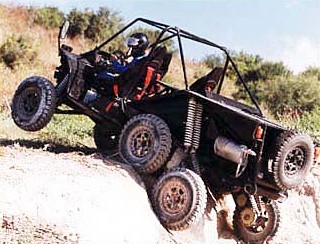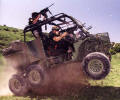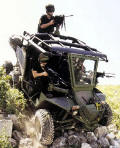

The Desert Raider was especially designed to meet the operational needs of Special and Rapid Deployment Forces for a new generation of fast, highly mobile attack and surveillance vehicle, which can operate behind enemy lines. As such, the Desert Raider is fully airborne and can be easily inserted into a CH53 size helicopter. Moreover, the vehicle has a low noise and thermal signature, which makes it a hard vehicle to detect, and an ideal tool for close up Long Range Reconnaissance Patrol (LRRP).
The hard core of the design concept is a unique 4-wheel rear suspension unit that features an independent suspension for each pair of rear wheels. The unit incorporates a pivot axis, on which the vehicle can rise or fall, and the Desert Raider is able to move with just one of its 6 wheels touching the ground. This system enables the vehicle great navigability and enhanced cross-country maneuverability over all types of terrain. As result of the rear suspension the vehicle can climb on a 70 degrees side slop, go over a 60 cm slope and is waterborne fording up to 70 cm without any special preparation.
The Desert Raider has an automatic transmission, a powerful engine and flexible yet rugged frame, which further contribute to the mobility and maneuverability under extreme field conditions and harsh terrain.
The Desert Raider has a maximum speed of 110 KPH, weights 1450 kg empty, can take a load of up to 1200 kg, and with a full fuel tank has an operational range of 600 km. The vehicle is designed for five man crew - three in the front and two in the back. The basic attack configuration is composed of three Israeli Military Industries (IMI) Negev 5.56 mm Light Machine Gun (LMG).
The system was tested by several Israeli Defense Force (IDF) elite units, including by Sayeret MATKAL - the IDF primary SF unit - but it yet to enter active duty. The vehicle is due to enter service in 2002 with several elite SF units pending on budget.


Desert Raider fitted with an IMI Negev LMG.

Same caption as above.

Same caption as above.